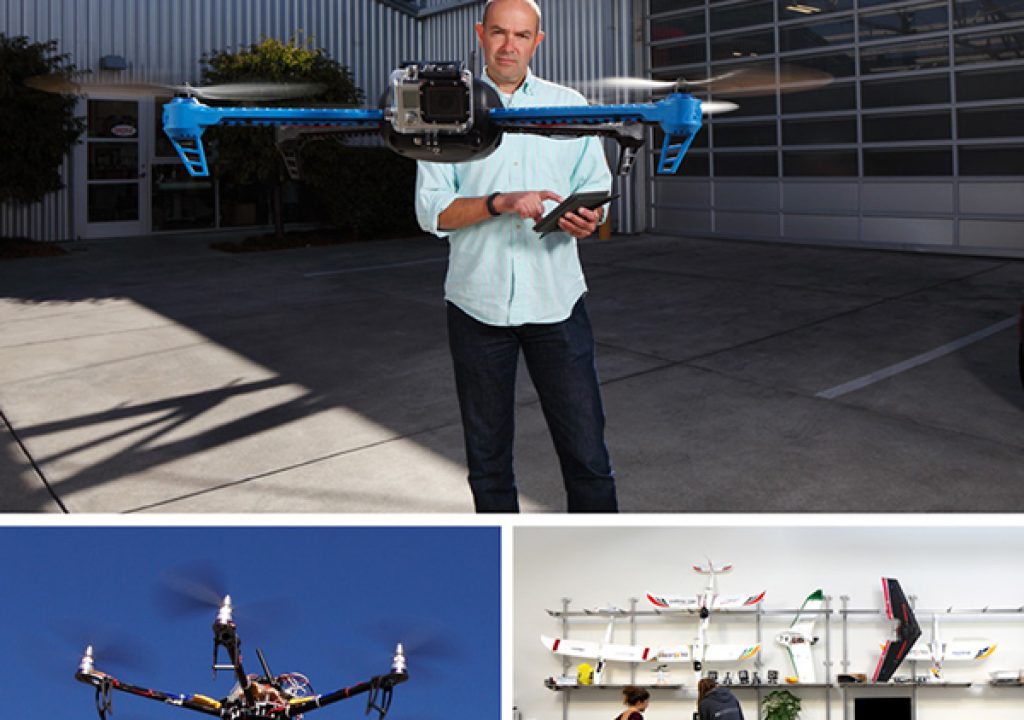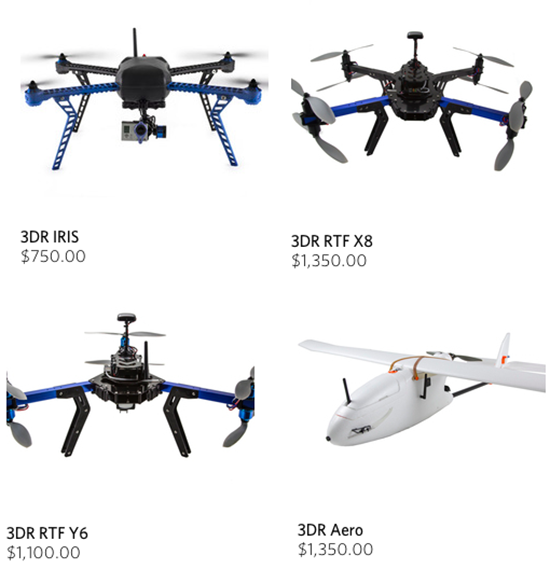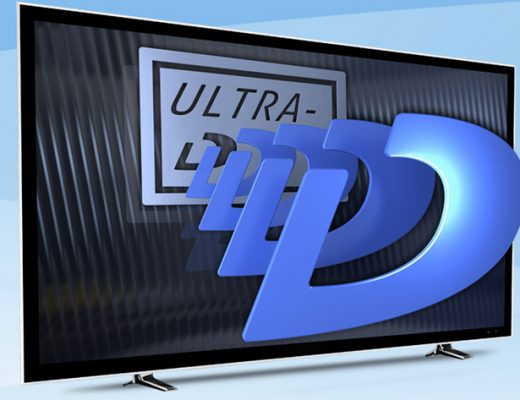You might hear the name 3D Robotics and say “Oh yeah, I've heard of those guys. They also make small UAVs don't they?” …and you'd be right.. kind of. I take a closer look at this innovative company and peek into the future with one of the industries' great visionaries and technology leaders… and I get excited for what this all means for aerial imaging!
What started out as a simple request to review some of the 3D Robotics drones, has quickly become an obsession of diving deep into the autonomous technology that drives these aerial imaging machines.
And no, this isn't going to be the story about Chris Anderson, the former editor of WIRED and CEO/founder of 3D Robotics – nor how they got started in the first place; as that's been told before and you can catch up on your reading online here, and here, and in this USA Today article with a video interview.
This is more about looking at 3D Robotics approach to autonomous navigation with drones, cameras, imaging, the present and the future.
3D Robotics – The Hardware
Okay – let's start with the obvious… the lineup of 3D Robotics' hardware. What's the out-of-the-box experience like? How do they compare to other manufacturers' product offerings and are they easy to fly?
3D Robotics offers 4 major ready-to-fly craft: the 3DR IRIS quadcopter, $750 complete with controller), the 3DR RTF X8 (quad frame with dual inverse-mounted motors on each shaft, $1,350), the 3DR RTF Y6 (three arms, 6 motors, $1,100) and the 3DR Aero (fixed-wing long-range plane, $1,350). Both the X8 and Y6 also come in a DIY kit form that you can build with your own electronics or choose from a selection of 3D Robotics gear. All of these craft feature the 3DR Pixhawk autopilot hardware controller, which utilizes the GPS for controlled flight stabilization or through computer/tablet assisted autonomous flight planning software.
![]()
The IRIS is very much a rev.1 product – which means it still has a few kinks to work out, but it’s still a capable craft for doing some basic flight tasks. I've taken the IRIS to task in both radio controlled and flights and sent on autonomous missions – but only very short distances. Battery life isn’t great with a 2-axis Tarot T2 gimbal and a GoPro, but I’ve heard there will be some updates soon to improve this greatly. Stay tuned for more updates in the near-future, as I can't wait to see what improvements 3DR has for this model.
![]()
I have also had a chance to test out the Y6, which so far has been my best flying experience to date. It has the lift and the stability of a hex with a much smaller footprint plus nimble maneuverability that blows-away a quadcopter. The unit I’m testing has FPV and a Spektrum DX7s transmitter currently. I can’t wait to see what modifications and updates can be done with this airframe over time. I will be posting my first full product review of the Y6 shortly.
![]()
In my 2-day Drone Workshop on CreativeLive, I had 3D Robotics' Colin Guinn join me to demo some of their craft, but unfortunately due to time constraints and technical issues with the live stream and FPV, we couldn't get to everything.
Here Colin is showing us the X8. I haven’t yet had the opportunity to do any test flights with an X8 yet, but judging from the many user comments, posts and videos in the Facebook forums, it looks like a solid piece of gear as well.
![]()
He also showed us the 3DR Aero and explained some of the features of it in the video workshop.
![]()
I will be doing more extensive hardware product reviews once I have some flight time on each of these machines, but be on the lookout for announcements regarding some new products from 3D Robotics in the coming months – which I’ll be sure to share in this channel as soon as information is available.
Continued on Next Page –> (2 of 3)
Autonomous Flight with 3D Robotics Software Technology
The beauty of 3D Robotics software technology is that it’s open-source and developers around the globe are contributing to make amazing free software products to control autonomous missions with your 3DR-enabled craft, utilizing the Pixhawk or Ardupilot autopilot hardware. The developers are constantly tweaking and updating the tools for optimal performance and even the beta versions can be easily downloaded and tried in most cases. Did I mention they're also FREE?
![]()
The online community that supports all these efforts is DIYDrones.com – created by Chris Anderson himself and has a very active and supportive membership from what I've seen to date. Anything you could wish to see/read/learn about this industry you'll discover someone is planning, experimenting, building or testing the concepts in this amazing community.
Some examples of this development are APM:Copter and APM:Plane, APM Planner and Mission Planner software, and there’s DroidPlanner for Android devices that you can download from the Google PlayStore.
APM:Copter allows you to send your multirotor copter or helicopter on autonomous missions to selected waypoints for capturing images, video or data. This takes total flight control of your craft and requires no additional user input once the mission program is uploaded to your copter and sent on its way. The APM:Plane (formerly ArduPlane) firmware running on the APM autopilot gives any fixed-wing aircraft full autonomous capability. The software provides advanced functions such as support for hundreds of three-dimensional waypoints, automatic takeoff and landing as well as sophisticated mission planning and camera controls.
![]()
![]()
It works with the desktop Mission Planner ground station software to offer a complete UAV solution. Programming and mission operations are done through an elegant and well-developed software interface. The entire package is designed to be easily approachable for the novice, while remaining open-ended for custom applications, education, and research use.
You can learn more or download all the the software for free from the 3D Robotics website or the APM software download page.
DroidPlanner 2 for Android Devices (Beta) –
The DroidPlanner 2 app for Android is still in Beta but I've found it to work pretty well in “Survey” mode. Unlike other iOS apps that simply give you waypoints for sending your craft on a simple mission, DroidPlanner 2 allows you to accomplish much more sophisticated missions, such as sending your craft out to a waypoint and flying around it at a predetermined radius – all while keeping the craft pointed directly at the center of the waypoint. This is a camera move that is nearly impossible to nail exactly in a manual mode – especially if you're fully reliant on only FPV piloting. This is the kind of automation that makes your heart race with teh possibilities!
I did a short test with my Y6 and a survey plan of a construction site near my home in the East Bay. I simply drew out an area on the map with my finger and it automatically created an outline with waypoints and draws out a flight grid that tells the craft to make a swath back and forth to cover the entire are, so you can shoot images or collect FLIR data over a field/location and be able to have 100% coverage (depending on the camera/configuration you have setup on your craft).
![]()
In my 2-day Live Drone Workshop, we got to see the live demo of this beta release of the software from Colin Guinn, using a Nexus tablet controlling an IRIS around the “Bliss Dance” statue on Treasure Island.
![]()
Features:
- Completely redesigned graphical user interface
- Specifically designed for 3DR multirotors and Iris
- New telemetry screen showing quick glanceable info: HUD, battery, RSSI, distance
- Easy to use Home, Land, and Loiter buttons
- New guided mode with changeable altitude
- Quick mode switching
- New planning screen for quick mission generation
- Easy and powerful mission editing tools
- Basic radio TX setup
- Preflight checklist
Coming soon:
- Survey tools in the mission planning screen
- FollowMe 2.0 with advanced control options
- New flight tuning screens
- Improved radio configuration
Droneshare.com
Another amazing service from 3D Robotics is their newly-launched site called Droneshare.com (currently in Beta). Droneshare is an automated flight data recording/sharing service that works with your flight planning software applications that enable sharing of your flight data. Once you've registered with the site and have enabled your software to share the data, it will post your flights on the website mapping your location, flight time, craft type and show the actual flight path on a particular date. I'm going to start connecting soon as well, so watch for my upcoming flights on Droneshare.com.
![]()
Continued on Next Page –> (3 of 3)
Commercial, Industrial, SAR and Agricultural Applications
With any of the manual R/C, FPV and autonomous features of the 3D Robotics gear, the uses for commercial, industrial, construction, archeological, SAR (search & rescue) and agricultural applications become quite obvious.
More than just another piece of FPV hardware that enables you to take stable aerial photos & videos, the combination of 3D Robotics hardware/software is perfectly aligned with the needs of commercial and agribusiness. The Survey mode in the DroidPlanner app alone would make great use of the Y6 to do a sweep of an area with a FLIR imaging camera and FPV monitoring to get a good portable SAR system in the air! (something I'm hoping to build myself later this year).
3D Robotics has been experimenting with different types of imaging and data collection – not just getting pretty photos and video footage. There have been numerous applications utilizing the images and telemetry data gathered on a flight mission to create 3D imaging/mapping.
Here's an example of a flight by Brandon Senn on YouTube, showing his planned flight and the using the images and telemetry data to provide a good model of an area captured with his 3DR X8:
And a new term I'm seeing these days is “Precision Agriculture“. Last year, Forbes even published an article on the topic of the Growing Use of Drones in Agriculture. The MIT Technology Review also featured 3D Robotics in a recent article on Agricultural Drones.
The use of drones has been an important aspect of farming in parts of Asia for years, but just recently catching on here in the US – despite the empty threats and fear tactics the FAA is imposing on the commercial use of small UAVs & FPV drones to stop it. 3D Robotics has been leading this move in the industry and are presenting the technology at major Agricultural events.
Everything from vineyard irrigation analysis and crop maturity to weed mapping in large crops, farmers can now use modern technology to help them manage their crops with less time and resources – which also means less waste.
![]()
Ranchers are also discovering that a quick 5-10 minute aerial flight over their livestock grazing helps them easily manage where the herds are located and how they are doing through FPV – without spending hours on horseback or their pickup trying to locate them. This way if they do see a problem or need to manage the herd, then can pinpoint the location and go directly to them.
![]()
As the technology advances and the uses for 3D Robotics hardware and software continues to grow, I'll be updating my channel here on ProVideo Coalition with not only new product reviews, but share HOW these are being used out in the world.
Please comment below and share some of your stories and uses for the technology as well… I always welcome comments!
_____________________________________________________________________________________
Jeff Foster is a published author of several how-to books and training videos in the motion graphics, animation and video production industries and is an award-winning video producer and artist. Visit his web site to learn more about his training methods, tips & tricks at PixelPainter.com

Filmtools
Filmmakers go-to destination for pre-production, production & post production equipment!
Shop Now














